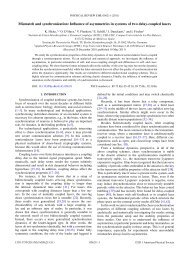DBI Analysis of Open String Bound States on Non-compact D-branes
DBI Analysis of Open String Bound States on Non-compact D-branes
DBI Analysis of Open String Bound States on Non-compact D-branes
Create successful ePaper yourself
Turn your PDF publications into a flip-book with our unique Google optimized e-Paper software.
CHAPTER 2. BOSONIC STRINGS 36For the first excited level though, we now have many more possibilities, since thesestates are given byα−1˜α i j −1 |0〉, (2.138)and both excitati<strong>on</strong>s are essentialy independent. This results in 24 2 = 576 masslessstates. However, the fact that these excitati<strong>on</strong>s are indepent has a huge c<strong>on</strong>sequence,namely it allows us to decompose the states in three distinct parts as follows:[α−1α i j −1 |0〉 = α[i −1˜αj] −1 |0〉 + α −1˜αj) (i−1 − 1D − 2 δij α−1˜α k −1k]|0〉+ 1D − 2 δij α k −1˜α k −1|0〉, (2.139)where [...] stand for anti-symmetrizati<strong>on</strong> and (...) stand for symmetrizati<strong>on</strong>. Thus we obtainan anti-symmetric part, a traceless symmetric part, and a part that is proporti<strong>on</strong>alto the unit matrix. And now comes the moment you have all been waiting for: thegravit<strong>on</strong> has entered the building! Admittedly, we are skipping a few steps here, butwe can nevertheless already identify the traceless symmetric part <str<strong>on</strong>g>of</str<strong>on</strong>g> Eq. 2.139 with amassless spin two particle described by a traceless symmetric rank two tensor, usuallydenoted g µν . It turns out though that if <strong>on</strong>e would investigate how this particle couplesto matter and to itself, it does indeed behave like a gravit<strong>on</strong> (cfr. [14], Chapter 15).Furthermore, we also find ourselves in the lovely company <str<strong>on</strong>g>of</str<strong>on</strong>g> a massless antisymmetricrank two tensor, which is called the Kalb-Ram<strong>on</strong>d field and denoted B µν , and a masslessscalar which resp<strong>on</strong>ds to the name dilat<strong>on</strong> field and denoted Φ, both <str<strong>on</strong>g>of</str<strong>on</strong>g> which will playvery important roles later <strong>on</strong>.Note that in the case <str<strong>on</strong>g>of</str<strong>on</strong>g> the closed string, the generating functi<strong>on</strong> trick describedfor the open string case does not apply. The origin for this lies in the level matchingc<strong>on</strong>diti<strong>on</strong>, Eq. 2.102, combined with the commutators for the modes, Eq. 2.53. The commutati<strong>on</strong>relati<strong>on</strong>s show that an m-level operator weights more than an (n < m)-leveloperator, resulting in the fact that <strong>on</strong>e cannot simply write down an elegant generatingfuncti<strong>on</strong> for this situati<strong>on</strong>, but has to verify the level-matching <strong>on</strong> a level-per-level basis.2.7 Oriented vs. unoriented stringsWe note in passing that <strong>on</strong>e could define a projecti<strong>on</strong> operati<strong>on</strong> that projectsσ −→ π − σ, (2.140)i.e. it flips all points <strong>on</strong> the string around the centerpoint. The c<strong>on</strong>sequence <str<strong>on</strong>g>of</str<strong>on</strong>g> thisoperati<strong>on</strong> for the mode expansi<strong>on</strong>s isopen strings: α µ m ←→ (−1) m α µ m, (2.141)closed strings: α µ m ←→ ˜α µ m. (2.142)<str<strong>on</strong>g>String</str<strong>on</strong>g>s unaffected by this operati<strong>on</strong> are called unoriented, in c<strong>on</strong>trast to their brethrenwho do feel the operati<strong>on</strong> and are called oriented.
















